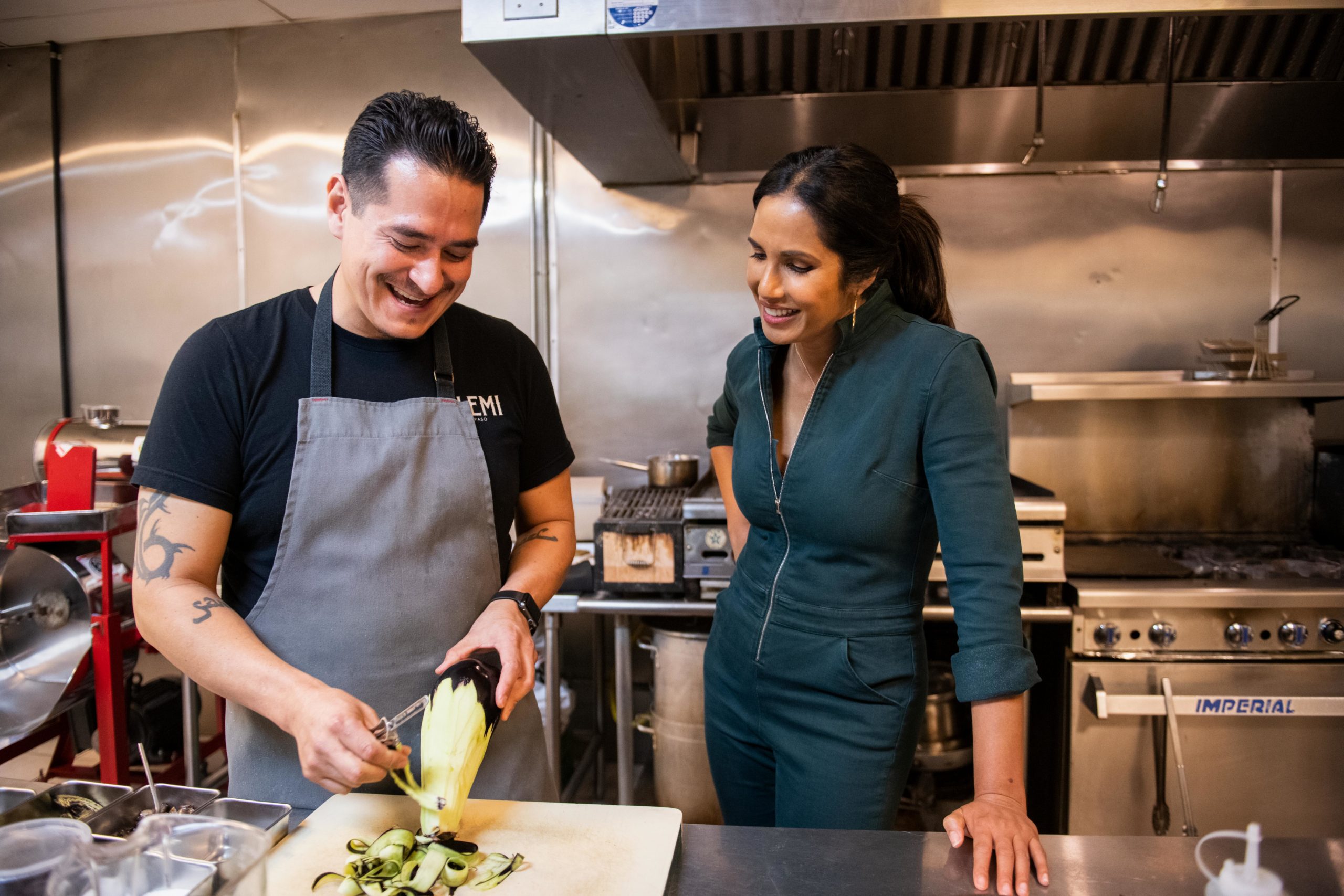
It’s hard to believe that Taste the Nation with Padma Lakshmi is the famous chef’s first show that she’s headlined. She’s been a ubiquitous presence in cooking and lifestyle media hosting Top Chef and with her cookbooks, but with this overall excellent Hulu series she gets to present to TV audiences her own unbridled passion for food, culture, and the immigrant experience. Taste the Nation with Padma Lakshmi is an informative and often emotional look at how immigrant communities across the US create and maintain their cultures with the fundamental power of food.
Padma’s stated journey for the show is to determine, “What makes us American?” We so often tell ourselves that we are a nation of immigrants, but what does that look like in practice? How do intra and inter-community tensions come into play? How do cultural diffusion and evolution play into food and other aspects of these communities? Padma has sincere warmth and affection for the people she visits, and vocal appreciation of their food cultures. She approaches everyone with she meets with empathy for their experiences. Additionally, she has a keen interest in how assimilation happened and happens across the communities she visits.
This is a series firmly rooted in exploring the immigrant experience, and it’s refreshing in that regard. It includes an episode on Padma and her mother’s own immigrant story and a general look at the Indian-American experience. There is a distinct focus on generational change in each of the communities, and how each generation assumes their identity in the US. Food is often the entryway of learning more about people and their cultures. This overall works to great effect, although it sometimes feels the show should prolong these important conversations beyond the half-hour limit of each episode.
Through meeting Thai, Indian, Peruvian, Persian, Chinese, Gullah, Navajo, and more communities across the US, Padma provides an intimate look at American lives. The audience learns more about the nuances of immigrant experiences, with them telling their own stories of how they came to be here or how, in the case of Native and Gullah, colonization, slavery, and genocide forced them to be in this country, and how they reclaim their culture after undergoing their societal traumas.
One episode focuses on Navajo and Apache cuisine in Phoenix, and the overall concept of “food sovereignty.” After enduring genocide, Native Americans saw their food culture destroyed. Padma shows audiences how the government forced many of these tribes to eat subsidized foods, which led to many health problems in their communities. Now they are working to reattain their food culture use their traditional ingredients that the government had cut them off from. Refreshingly, Taste The Nation addresses these difficult topics without coddling the audience. It is so critical to face the horrific aspects of American history, especially now.

In one crucial episode, Padma meets the Gullah and Geechee people who are descended from West Africans, originally brought to this country as slaves. In providing a platform to tell their and other stories, the show conveys the more horrific aspects of food culture, and how the colonialist demand for certain foods nearly decimated these communities. The Gullah and the Geechee, despite the horrors thrust on them, have survived and thrived. They have their distinct cultivation and cooking practices intact. While their food culture remains under threat from climate change and gentrification, it’s vibrant and innovative with the array of dishes they make. This is a community that mainstream American food media has often ignored, and it’s so important that the show features them.
Taste the Nation offers a keen sociopolitical view, such as its first episode in El Paso, Texas. Here, Padma interviews Mexican-Americans and gives them a space to talk about their daily lives. It offers a granular glimpse into communities beyond just what headlines will tell you. Food is a core aspect of community and even plays into protecting their communities from deportation. Padma visits an ACLU center that both fosters community with local food and informs residents of their rights.
In this case and other times in the show, however, the exploration of racism communities face still feels cursory and surface-level. While Padma and her guests do discuss racism, the show can absolutely go into more depth on how food appropriation ties into racism and colonization. But Padma still gives audiences lessons in the historiography of many of the foods featured. Particularly she explains how colonization affected Mexican and Central American food culture. While informative, it does beg to go deeper.
Taste the Nation allows immigrant communities and cuisines to shine in a major way. The episode featuring Persian food and culture is incredibly emotive. It’s a deeply humanizing look at Iranian-American people, whom American media rarely gives a spotlight to. The discrimination Iranian-Americans have faced has inhibited their exceptional cuisine from going more mainstream in the American food scene. In connecting with Persian families, Padma shows how connecting with the food of our family’s original country is the most intimate way of connecting with our culture. With many episodes like this, the show has a wonderful and emotional poignancy that many will appreciate.
Food is at the heart of community. It is the driving force, literally and often figuratively, for our daily lives. Padma Lakshmi shows she understands this intimately with each community she visits. Giving these Americans the limelight to relay their experiences to the nation at large is incredibly important. Food is ultimately key to creating empathy for so many of these shunned immigrant communities. Taste the Nation allows them, through their food, to shine through to the average audience member watching.
Taste the Nation with Padma Lakshmi opens so many conversations about food and immigration that are long overdue in major American food media. It’s an intimate look at the experiences of many American communities and allows them to assert their complex and varied identities on screen. By showing delicious food from communities of color and giving rich discussions on everything that goes into making it, it’s a wonderfully informative watch. While it can still go deeper into conversations on more of the struggles these communities face from systemic racism and food appropriation, this is still an excellent start to a great series.
You can start streaming Taste the Nation with Padma Lakshmi now on Hulu.
Taste The Nation with Padma Lakshmi
-
Rating - 9.5/109.5/10
TL;DR
Taste the Nation with Padma Lakshmi opens so many conversations about food and immigration that are long overdue in major American food media. It’s an intimate look at the experiences of many American communities and allows them to assert their complex and varied identities on screen. By showing delicious food from communities of color and giving rich discussions on everything that goes into making it, it’s a wonderfully informative watch. While it can still go deeper into conversations on more of the struggles these communities face from systemic racism and food appropriation, this is still an excellent start to a great series.








